The Samsung Galaxy S25 Edge is a mere 5.8mm thin, yet has the fastest Qualcomm 8 Elite and, of course, the Galaxy S-series heritage.
Let me start by saying that we did not set out to find if thin equals compromises and whether these may impact your choice of S25s, including the standard S25, S25+, and the superb Samsung Galaxy S25 Ultra – its best glass slab yet (smartphone review).
It did not influence the tone of this 100% objective review, which is backed by over 70 tests and more than 300 data points that we conduct for every phone.
Upfront, let’s address the Samsung Galaxy S25 Edge positives
- Thin, thin, thin and light.
- The latest Qualcomm SD8 Elite for Galaxy offers the best raw processing power, graphics and AI.
- The camera is great, but it’s lacking the telephoto lens found on some S25 Models.
- Gen 2 Samsung AI for those who can use it.
- 2+7+7 warranty/OS upgrades/security patches are unbeatable
- Superb build quality with a square edge titanium exoskeleton (like iPhone 16)
- Samsung is the world’s largest manufacturer of Android smartphones.
- Retains more trade-in and second-hand value.
What are the main ‘thin’ compromises?
Shrinking this down introduces issues that may or may not affect you.
- Processor: Gets very hot (99°C) and throttles over 40% under load. This affects gamers and power users. The exterior reaches 45° under load.
- USB-C 3.2 Gen 1 does not support external mountable SSD storage, which affects video editors and photographers.
- The 3900mAh battery means typical users must recharge daily, and power users may only get 5-8 hours of on-screen life.
- Screen: 240/480Hz deep Pulse Width Modulation affects all PWM-sensitive users. This applies to any Samsung brand AMOLED phone.
- 4G/5G: It only has reception strength for the city and suburbs. This is unusual for a Qualcomm SD8 Elite modem. Likely aerial related.
- GPS: 3m accuracy, likely aerial related.
- Comms: More variation between upper and lower Wi-Fi speed tests, likely aerial related.
- Camera: 200MP bins to 12.5MP with AI – good but not class-leading. No telephoto, only 8X/10X crop from full frame.
Australian Review: Samsung Galaxy S25 Edge, 12/256GB, SIM and eSIM, Model SM-937B as of 1/7/25
| Brand | Samsung |
| Model | Samsung Galaxy S25 Edge |
| Model Number | SM-937B |
| RAM/Storage Base | 12/256 |
| Price base | $1849 but currently $1449 |
| Price 2 | 12/512GB $2049 but currently $1649 |
| Warranty months | 24 |
| Teir | Premium Thin |
| Website | Product Page |
| From | Samsung Online and approved retailers |
| Country of Origin | Vietnam (also made in India) |
| Company | Samsung is a South Korean multinational manufacturing conglomerate headquartered in Samsung Town, Seoul, South Korea. Samsung Electronics is the world’s largest information technology company, consumer electronics maker and chipmaker. |
| More | CyberShack phone news and reviews |
| Test date | July 2025 |
| Ambient temp | 8-16° |
| Release | May 2025 |
| Other models not for Australia (Don’t buy) | Do not buy SM-S937U, SM-S937U1, or SM-S9370. |
Ratings
We use the following ratings for many of the items below. CyberShack regards 70/100 as a pass mark. You can click on most images to enlarge them.
- Fail (below expectations), and we will let you know if this affects its use.
- Pass(able) rating that is not as good as it should be.
- Pass (meets expectations).
- Pass ‘+’ rating to show it is good, but does not quite make it to Exceed
- Exceed (surpasses expectations or is the class leader).
How to make the best use of this deep dive review
We tested over 70 different aspects and uncovered nearly 300 key data points about the device. Overall reviews can reach a few thousand words. So, if you are keen, this is the world’s most comprehensive review!
If you want to see our impressions only, they are listed at the beginning of each table. At the end, you will find CyberShack’s view, competitor analysis, and ratings. Ratings are based on the price bracket and expectations, so a $200 phone may score as well as a $2000 phone—we compare like with like.
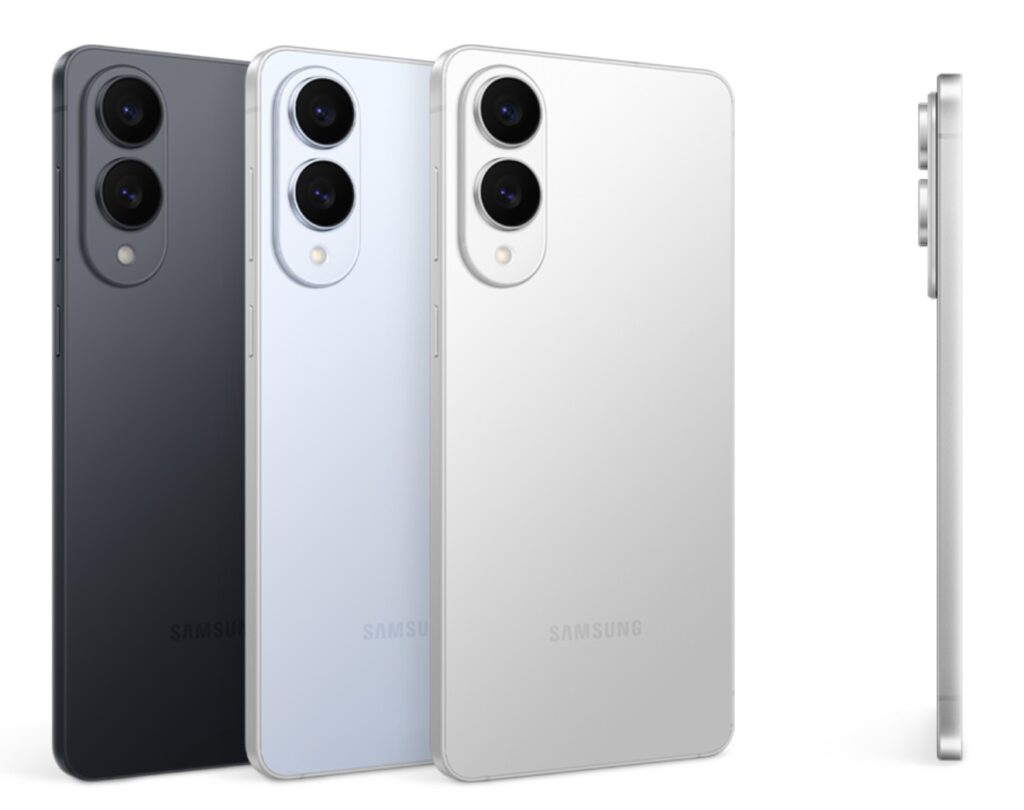
First Impression – Thin 5.8mm with S25 design cues
According to commentators, this is to counter the upcoming iPhone 17 Air, rumoured to be 5.65mm. Yes, it is thin, but considering the camera hump, it is actually closer to 10mm. Said hump allows it to rock when on the desk.

It feels good in hand, but it gets a bit toasty (45º to touch) if under load – great in Winter.
According to the teardown (later), it has a titanium exoskeleton wrapped around a plastic substrate and an aluminium frame. It withstands typical bend tests, so it’s safe in the back pocket of your jeans.
Screen – Pass
Samsung uses an 8-bit/16.7m colour AMOLED screen, which means:
- It does not have full DCI-P3 coverage (only 10-bit does), so it is a percentage of 16.7 million colours, not 1.07 billion.
- Does not support Dolby Vision (ditto) but uses Samsung’s HDR10+ royalty-free video codec.
- Colour banding in HDR10+ content is evident.
- Video and still Image previews are not colour-accurate.
- And it has 240/480Hz deep Pulse Width Modulation affecting all PWM-sensitive users. This applies to any Samsung brand AMOLED phone.
Read 8-bit versus 10-bit screen colours. What is the big deal? and PWM – Is your phone making you sick?
On the plus side, Samsung supplies these screens to Apple and Google Pixel, so they all have the same issues. An 8-bit screen is more energy-efficient than a 10-bit.
| Size | 6.7″ |
| Type | Dynamic AMOLED 2X |
| Flat, Curve, 2D, 3D | Flat |
| Resolution | 3120 x 1440 or 2340 x 1080 (as tested) or 1560 x 720 |
| PPI | 513 |
| Ratio | 19.5:9 |
| Screen to Body% % | 92.1% |
| Colours bits | 8-bit/16.7m |
| Refresh Hz, adaptive | 120Hz The screen supports 10, 24, 30, 48, 60, 80, and 120Hz stepped or 60Hz fixed refresh rates. |
| Response 120Hz | Not disclosed |
| Nits typical, test | Test: Manual (not adaptive) 745 nits Adaptive: 1330 Typical 300-400 nits |
| Nits max, test | Test: 2695 nits in 2% windows with HDR10+ content |
| Contrast | Infinite |
| sRGB | Test: sRGB is only 8-bit Vivid: 112 Natural: 100 |
| DCI-P3 | Test: (8-bit, 16.7 million colours) Vivid: 92% Natural: 90% |
| Rec 2020 or other | Has a Vivid slider and can be RGB colour calibrated. |
| Delta E (<4 is excellent) | Test: 4 – far higher than expected and at the edge of perceptible colour accuracy. |
| HDR Level | Supports up to HDR10+ and locks the refresh rate at 120Hz. Samsung does not support Dolby Vision on any of its devices. |
| SDR Upscale | No |
| Blue Light control | Yes, but it seems to be impacted by PWM flicker as well. |
| PWM if known | Yes, 240/480Hz with deep modulation. It can cause headaches and eyestrain with extended use. It is not for PWM-sensitive people. It’s the same type of screen used in the Apple iPhone and Pixel 7/8/9 series. |
| Daylight readable | Yes, but does not have the same extent of anti-glare finish as other S25s. |
| Always on Display | Yes |
| Edge display | Yes |
| Accessibility | Full suite of enhancements |
| DRM | Widevine L1 1080p SDR and some HDR streaming |
| Gaming | Game mode not tested |
| Screen protection | Gorilla Glass Ceramic 2 created for the S25 Edge Mohs 6 – no harder than GG Armor 2. Survives 1m drops. See the drop test video later. |
| Comment | It does not support 10-bit/1.07B colours, but since it does not support Dolby Vision, this is acceptable. This adaptive screen steps from 10 to 120Hz to help conserve battery. Samsung AMOLED is not for those who suffer from PWM. |


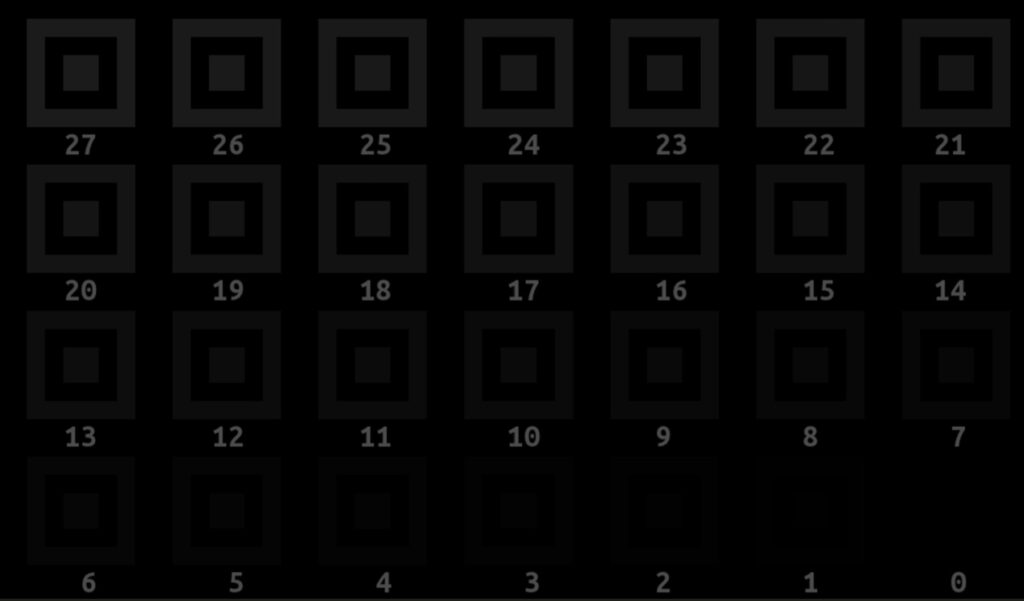

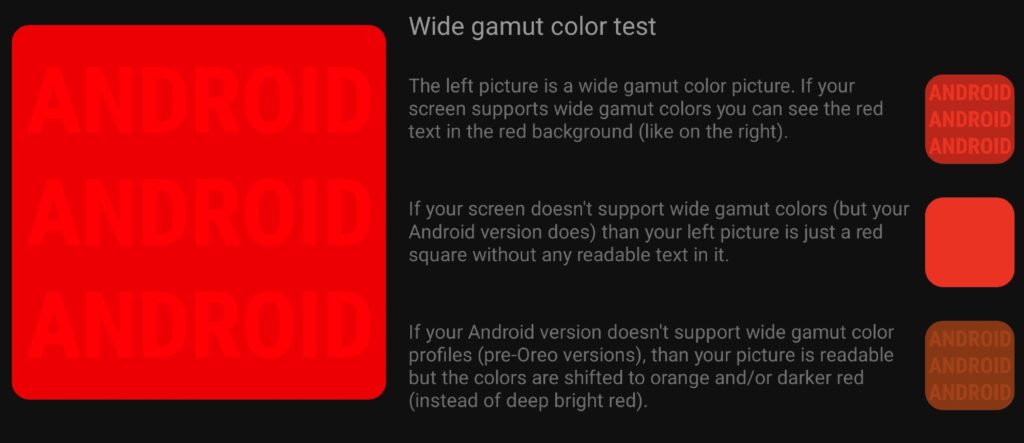
Processor – Exceed
Qualcomm’s Snapdragon 8 Elite powers all S25 models, which is the most welcome generational upgrade this year.
It appears to be throttled in comparison to the same processor in the S25 Ultra, which is understandable, given the potential heat issues of a thinner phone.
| Type | Adreno 830 1.2GHz |
| nm | 3nm TSMC N3E |
| Cores | 2 x 4.47 GHz + 6 x 3.53 GHz |
| Modem | X80 5G |
| GPU | Adreno 830 1.2 Ghz |
AI and performance tests – More than enough
The Processor has similar AI capabilities to the S25 range.
| AI | On charge Geekbench AI CPU: 1978/1866/3194 GPU backend 1316/2320/2259 NNAPI backend 648/608/1327 QNN backend 581/27415/61437 AiTuTu: 67171 AI Benchmark 6: 12087 GFLOPS: 22.65 GINOPS:36.94 |
| AnTuTu | 1,988,052 |
| Geekbench 6 Single-core | 2701 |
| Geekbench 6 multi-core | 9034 |
| Like | Benchmarks |
| GPU Test | |
| Open CL | 17,877 |
| Like | Fastest available. |
| Vulcan | 24,027 |
RAM and Storage tests – Pass
12GB is considered the minimum requirement for AI on-device processing. Google has declared 16GB as the minimum requirement moving forward, and we are starting to see 24GB as the standard for AI phones. If you want a little more future-proofing, the 16GB S25U is the way to go.
It does not support an external, mountable SSD for live storage.
| RAM, type | 12GB LPDDR5X |
| Storage, free, type | 256GB UFS 4.0 (200GB free) 512GB option. |
| micro-SD | No |
| CPDT internal seq. Read MBps sustained/peak | 2860/3960 |
| CPDT internal seq. write MBps sustained/peak | 857/1260 |
| CPDT microSD read, write MBps | N/A |
| CPDT external (mountable?) MBps | Won’t test – seen as external storage but can’t mount as internal storage |
| Comment | Without mountable storage, which is often referred to as internal storage, videographers and vloggers will soon run out of space. |
Throttle Test: Pass for typical use and FAIL for power users
This is the Achilles’ heel and is related to the Thin territory, although the S25U similarly suffers.
We conducted repeated end-to-end tests over time, and the maximum GIPs (Gigabit instructions per second) decreased from over 381,000 to around 250,000, likely due to AI protection measures implemented by the processor. To be clear, the more we tested, the more AI tried to give a better result.
It gets pretty toasty (45°), but we suspect you won’t be flogging it like we did.
| Throttle test | Cold Boot Ambient 15°/Typical use/Back-to-back tests. |
| Max GIPS | 381,226/304,254/250,126 |
| Average GIPS | 266,095/180,726/220,611 |
| Minimum GIPS | 233,298/152,127/200,601 |
| % Throttle | 40/41% |
| CPU Temp | 99°/99 |
| External Temp | 45° |
| Comment | There is massive throttling. Stress tests also saw GFLOPs and GINOPs drop severely. This is not for power users. Typical users will not see this. |
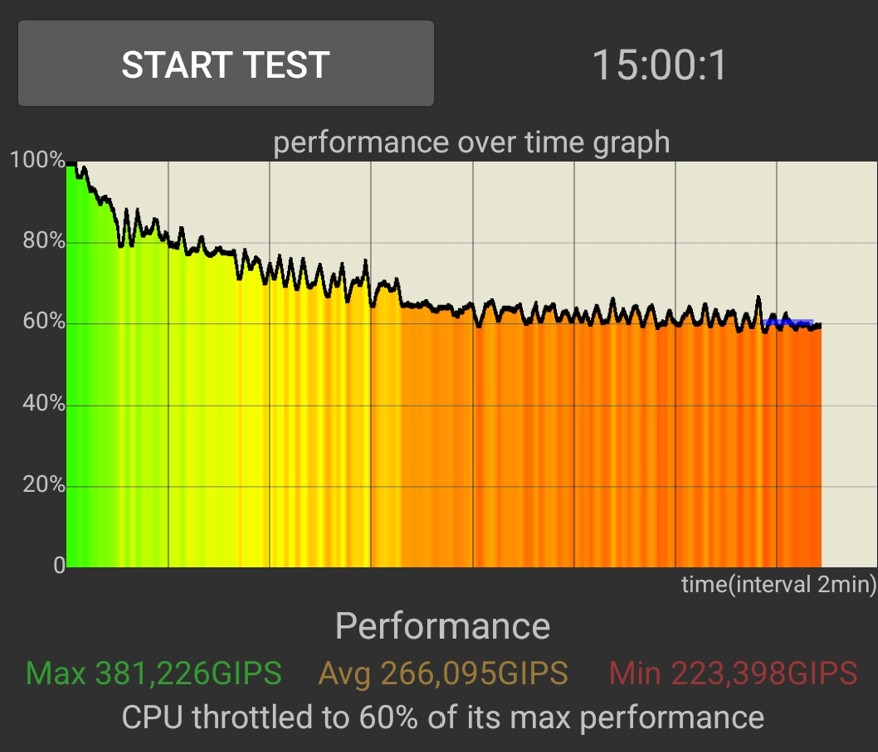

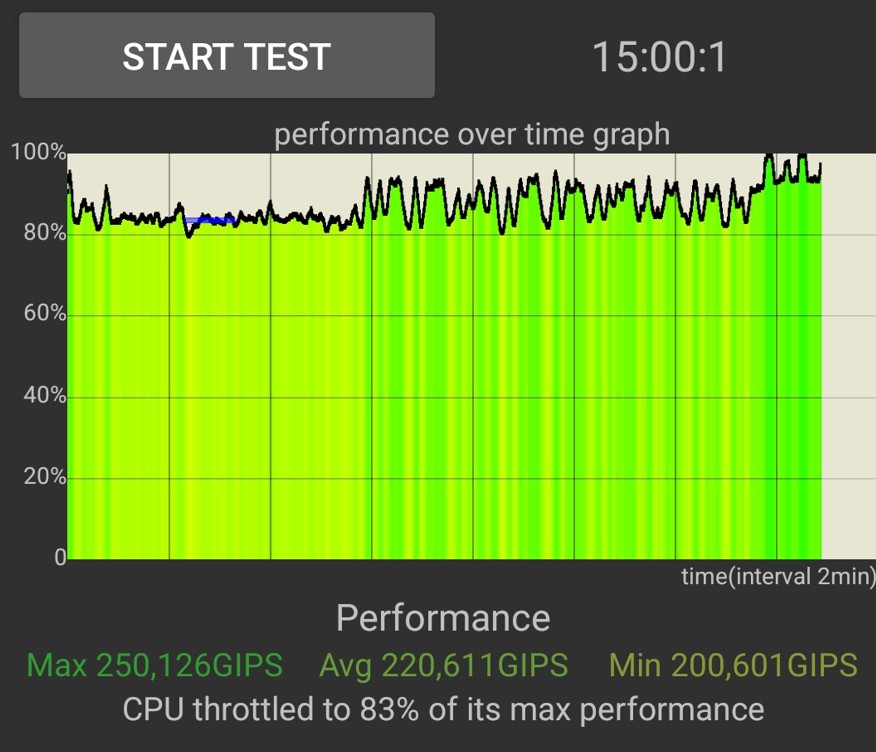
Comms – Pass – Three issues
First, the Wi-Fi 7 Rx/Tx (receive and transmit) speeds varied quite considerably during testing. It is normal to see a slight variation, but these were significantly higher, ranging from 50% to 100% from fastest to slowest. We test hands-off and in the same locations, so we can only assume that the antenna issues facing 4/5G and GPS also affect Wi-Fi. Fortunately, it is not a significant issue if Rx/Tx rates exceed a few hundred Mbps.
Second, the GPS has a 3m accuracy. Again, we suspect antenna issues with the thinner frame, and it’s not a significant issue for in-car navigation.
Samsung’s refusal to enable USB-C 3.2 Gen 1, 5Gbps, which supports full audio/video/data and charging standards, means that heavy users, such as videographers and vloggers, run out of space and must use slow, manual OTG cut-and-paste methods.
| Wi-Fi Type, model | Wi-Fi 7 2.4/5/6GHz 320Mhz Samsung does not reveal connection speeds, which makes it difficult for users to decide whether to use 5GHz, 6GHz, or MLO on later routers. |
| Test 2m -dBm, Rx/Tx Mbps | -35/4483 to 4932/3202 to 4484 |
| Test 5m | -41/2497 to 4325/2209 to 3843 |
| Test 10m | -47/1901 to 3587/1537 to 3203 |
| BT Type | 5.4 |
| GPS dual | GPS, Glonass, Beidou, Galileo, QZSS. The SoC is capable of much more, but we suspect that it does not have the aerials for dual or tri-band, and only accurate to 3m |
| USB type | USB-C 3.2 Gen 1 5Mbps |
| ALT DP, DeX, Ready For | Supports Alt DP 1.2 over USB for DeX by cable. No longer supports DeX to PC; use Microsoft Link to Windows instead. |
| NFC | Yes |
| Ultra-wideband | Yes |
| Sensors | |
| Accelerometer | Yes |
| Gyro | Yes |
| e-Compass | Yes |
| Barometer | Yes |
| Gravity | |
| Pedometer | |
| Ambient light | Yes |
| Hall sensor | Yes |
| Proximity | Yes |
| Other | Fingerprint sensor |
| Comment | Does not support full USB-C 3l2 Gen 1 standard. No mountable external drive. |


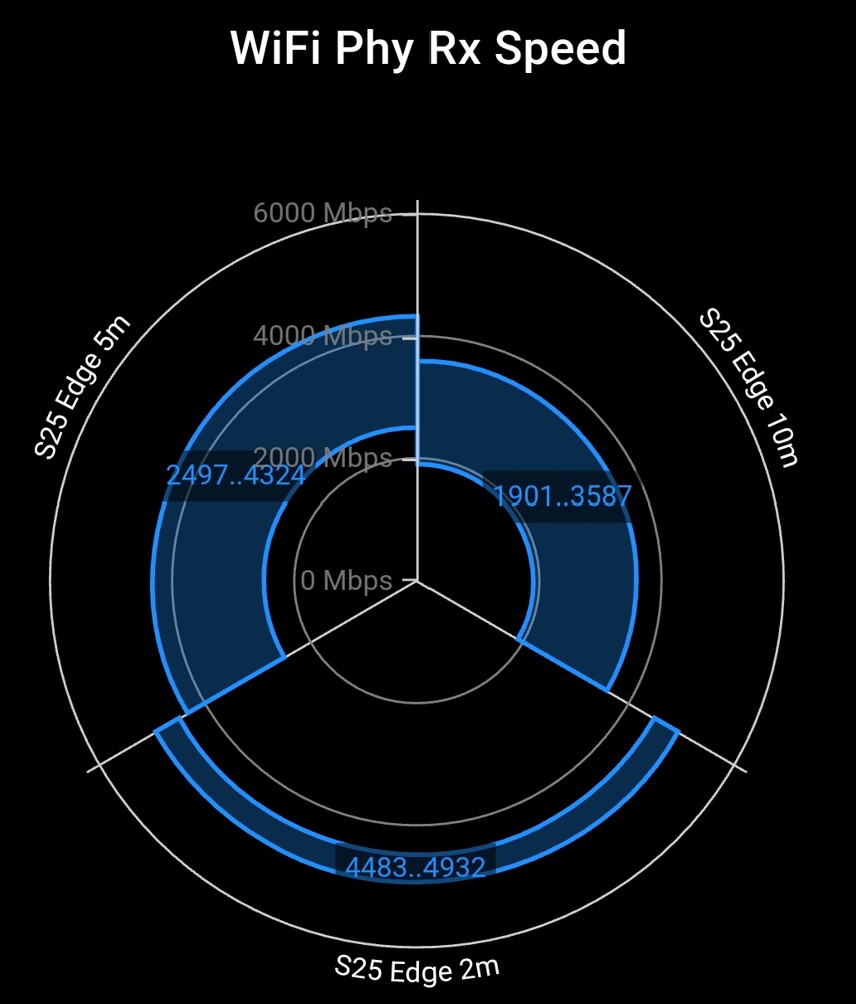

4/5G – Pass
Unlike the S25U, which earned an Exceed rating, this is only suitable for city and suburban use. The lower reception strength issue is well-documented on Facebook and Samsung’s community sites. Unfortunately for Samsung, the usual fixes — such as trying a different SIM, switching off 5G, and holding the phone differently — are not helping.
It seems to be related to the antenna design and the constraints of a smaller-width frame. It did not pick up 4G Band 28 or any 5G bands, unlike the S25U (our reference phone), which did.
It’s not an issue for city and suburban dwellers, but it’s a problem for black spots, regional, or rural areas.
| SIM | SIM and eSIM |
| Active | DSDA – dual SIM dual active data |
| Ringtone: single, dual | Single |
| VoLTE | Yes |
| Wi-Fi calling | Yes |
| 4G Bands | B1, 2, 3, 4, 5, 7, 8, 12, 13, 17, 18, 19, 20, 25, 26, 28, 66 |
| Comment | All 4G world bands |
| 5G sub-6 GHz | N 1, 2, 3, 5, 7, 8, 12, 20, 25, 26, 28, 38, 40, 41, 66, 77, 78 |
| Comment | All sub-6GHz and 5G low bands |
| mmWave | No |
| Test Boost Mobile, Telstra | |
| DL/UL, ms | 4G: 42/31/35m2 (slightly above average) 5G: No |
| Tower 1 -dBm FemtoWatt fW or PicoWatt pW (1000 fW) | 4G Band 3: -77 to -82 and 6.3 to 20pW 5G: No |
| Tower 2 | 4G Band 3: -84 and 4pW 5G: No |
| Tower 3 | 4G: No 5G: No |
| Tower 4 | 4G: No 5G: No |
| Comment | This is highly unexpected, as the S25 Ultra with the same modem was able to see four towers. A search reveals that the ‘Galaxy S25 Edge, despite being a flagship model, is experiencing reports of poor phone reception.’ One explanation is that there is only one 5G antenna, and the slimmer body limits the physical size of the antennas. This is suitable for the city and suburbs only. |


Battery – Pass
A typical user can expect 15-20 hours, while a power user can expect 5-8 hours. Another thin compromise.
First, you must discard any suggestions that it’s a 30-hour device. It reached 26 hours 13 minutes on a 1080p video loop at 50% brightness and volume. But the latest AI processors can tell if it is a video loop and put the rest of the phone to sleep – a nice parlour trick, and we will no longer regard that as an accurate reflection of screen time.
Similarly, AI can ‘game’ battery and performance testing apps, so we use traditional charge and discharge tests to make our battery life predictions.
Discharge time, screen on, 100% load, Wi-Fi/BT enabled, gave is a scant 3 hours. Even the S25U gets over 7 hours.
Change time: 1 hour 19 minutes with Anker GaN. Compared to other brands that now charge in <40 minutes, this is slow.
Make sure to carry a power bank – you’ll need it.
| mAh | Typical 3900mAh Installed 3.9V/3.786A/14.99Wh 5-year battery |
| Charger, type, supplied | No charger supplied. Fast Charge must be enabled in Battery settings |
| PD, QC level | 25W |
| Qi, wattage | 15W (not Qi2 magnet) |
| Reverse Qi or cable | 4.5W |
| Test (60Hz or adaptive screen) | Adaptive, Vivid and 2340 x 1080 |
| Charge % 30mins | 55% |
| Charge 0-100% | 1 hour 19 minutes Anker GaN 3 hours 34 minutes Samsung 25W charge 9V/2.77A/25W |
| Charge Qi, W | 10 hours using a Belkin 15W BoostCharge. Setting: Fast Wireless charging. |
| Charge 5V, 2A | 5 hours |
| Video loop 50%, aeroplane mode | 26 hours 13 minutes |
| PC Mark 3 battery | 15 hours 53 minutes Accubattery 15 hours 39 minutes |
| GFX Bench Manhattan battery | Out of memory error |
| GFX Bench T-Rex | 585.5 minutes (9.75 hours) 6711 frames |
| Drain 100-0% full load screen on | 3 hours |
| mA Full load screen on | 50% brightness 450-500mA 100% brightness 600-650mA |
| mA Watt idle Screen on | 150-200mA |
| Estimate loss at max refresh | Used Adaptive, so there should not be a major difference from fixed 60Hz. |
| Estimate typical use | This will need at least a daily charge for typical users. Power users can expect 3-5 hours of screen-on time. |
| Comment | AI detects a video loop and shuts down all phone functions to achieve terrific times – it’s no longer an accurate indicator of screen-on times. The smaller battery drains in 3 hours at 100% load, so power users will need to recharge it frequently. |
Sound hardware – Pass
For reasons unknown, Samsung does not use the excellent 7.3W Class-D Qualcomm Aqstic stereo and spatial sound amps built into the SD8-series SoC. Instead, it usually uses 2 x mono amps from Cirrus Logic or, in this case, adds a third Texas Instruments (TAS25XX) to handle the haptics. I suspect that it allows Samsung’s AKG to tune the speakers.
For reasons unknown, it does not support the full Qualcomm Bluetooth aptX codec family; instead, it opts to use the free basic aptX, SBC (Samsung Scalable Codec), AAC, LDAC, and SBC. Why? No royalties are paid to Qualcomm, just like Dolby Vision.
To achieve the best quality BT music, you should use LDAC-compatible earphones or Samsung’s SSC buds.
It does not have a built-in USB-C DAC (digital-to-analogue converter); several other brands allow direct plugging in of USB-C cables or 3.5mm buds. Instead, you must buy a USB-C with a 3.5 DAC, which is listed on Samsung’s Australian website as ‘Not for sale’. In any case, it is a very low-end DAC. If you prefer cabled music, Creative Sound Blaster offers the G3 DAC (<$90), and Astel & Kern has better DACs starting at $300-400. The difference in sound quality over BT is profound.
| Speakers | Stereo – top earpiece and bottom down-firing. |
| Tuning | Not specified – probably AKG |
| AMP | 2 x Cirrus Logic CS40l26 5W @1% THD+N, into 6Ohms 1 x TAX25XX Mono 2W that probably drives the haptics. |
| Dolby Atmos decode | Yes, down mix to two speakers |
| Hi-Res | No |
| 3.5mm | No, and you need an external DAC for cabled earphones. |
| BT Codecs | SBC, AAC, free aptX, LDAC and SSC (Samsung Scalable Codec). 16-bit/44100MHz |
| Multipoint | Can connect to two devices |
| Dolby Atmos (DA) | Yes – auto, movie, music, voice and games mode |
| EQ | Balanced, Smooth, Clear, Bass Boost, Dynamic, Treble Boost, Custom. Also, Dialogue Boost (1-4kHz) and UHQ upscale. |
| Mics | 3 – with background noise suppression and stereo zoom in sound |
| Test dB – all on EQ flat DA off | |
| Volume max | 83 – higher than most |
| Media (music) | 80 |
| Ring | 86 |
| Alarm | 86 |
| Notifications | 80 |
| Earpiece | 70 |
| Hands-free | Good hands-free with noise cancellation. |
| BT headphones | Excellent left-right separation and DA make a significant difference in DA content. |
Samsung Galaxy S25 Edge – How Does It Sound? Passable
A casualty of thin is that the micro speakers are even thinner. It has a mid-sound signature: (bass recessed, mid boosted, treble recessed) – for a clear voice, but not for music, as it lacks bass and music feels flat, with no air or vitality.

| Deep Bass 20-40Hz | No |
| Middle Bass 40-100Hz | No |
| High Bass 100-200Hz | Building to 500Hz |
| Low Mid 200-400Hz | Still building |
| Mid 400-1000Hz | Flat |
| High-Mid 1-2kHz | Flat |
| Low Treble 2-4kHz | Linear decline to 11kHz |
| Mid Treble 4-6kHz | Linear decline to 11kHz |
| High Treble 6-10kHz | Linear decline to 11kHz |
| Dog Whistle 10-20kHz | Flattens out to 17kHz |
| Sound Signature type | It has a mid sound signature: (bass recessed, mid boosted, treble recessed) – for a clear voice, but not for music, as it lacks bass and music feels flat, with no air or vitality. |
| Soundstage | 2D is about as wide as the phone, with no obvious bias to one speaker. DA gives it a slightly wider 10cm soundstage but adds a little 3D height. |
| Comment | It lacks musically important low-mid bass, and the high bass is delayed. Mid and low-mid treble are fine for music genres that don’t need a lot of bass |
Build – Exceed
If there is one thing that Samsung excels in, it is build quality. This is superb, and the Teardown videos confirm that it is a very repairable phone.
The new Gorilla Glass Ceramic 2 increases a replacement screen to $503, which is well over the S25U at $375.
| Size (H X W x D) | 158.2 x 75.6 x 5.8 plus camera bump |
| Weight grams | 163 |
| Front glass | Gorilla Glass Ceramic 2 Mohs 6 1m drop |
| Rear material | Gorilla Glass Victus 2 |
| Frame | Thin Titanium frame over plastic and an aluminium chassis. |
| IP rating | IP68 |
| Colours | Titanium Silver Titanium Jetblack Titanium Icyblue (Samsung online) |
| Pen, Stylus support | No |
| Teardown | Jerry Rig below: Comment: Thin versus heat dissipation – thin won! Drop Test: 1.5m cracks the screen and 2m cracks the back glass. |
| In the box | |
| Charger | No |
| USB cable | Very short USB-C to USB-C 3W (25W maximum) |
| Buds | No |
| Bumper cover | No |
| Comment | Bare phone and short charge cable |
Drop test
Operating System – Pass
There are two components – Android 15 and its seven years of OS upgrades and security patches, and Samsung One UI 7.0, which will be updated at least annually.
Its 2+7+7 warranty, OS and patches are hard to beat. This does a few things:
- Helps retain second-hand and trade-in value for longer
- Stops the proliferation of Android versions on its phones.
- Make sure the latest security patches are applied
- Makes it easier to sell.
But ever so slowly, since the S20 (2020), I have seen Samsung’s relatively straightforward privacy policies and terms of use balloon into over 40,000 words and 8-10 interlocking nested policies that only a lawyer would understand, let alone NOT sign. PS—Google/OPPO/Motorola, do it in a few thousand words!
And now you cannot use a Samsung phone without a Samsung account. I am not inferring that Samsung is doing anything wrong, especially when Apple has been getting away with this for far longer. Samsung could consider returning to its roots as the premium Android smartphone maker and make its policies user and privacy-friendly. Privacy is humanity’s greatest threat.




Android versus Samdroid
Samsung apps often duplicate Google Apps, such as Calendar, Contacts, Browser, Files, Mail, Pay, etc. That is fine if you stay in Samsung’s walled garden and upgrade to new Samsung devices, which also require a Samsung Account.
As a phone reviewer, I need to use them for a few weeks, and my advice is to use Google Android apps and Google Backup to make phone changes easy.
We won’t delve into detail here about Samsung AI and Google Gemini, as this will be the subject of a separate review.
| Android | 15 |
| Security patch date | 1 June 2025 |
| UI | One UI 7.0 |
| OS upgrade policy | 7 to 2032 |
| Security patch policy | 7 to 2032 |
| Bloatware | Samsung’s alternative to Google Suite. Microsoft suite and OneDrive (requires subscription) |
| Other | Selection of Galaxy Apps. Including Gallery, My Files, Internet, Health, Calculator, Calendar, Wallet, the powerful Notes app, and Bixby assistant. Consumer Advice: If you intend to use other Android brands in the future, consider using Google Apps rather than being locked into the Samsung ecosystem. |
| Comment | Great upgrade policy and One UI is easy to use. Google Gemini AI features. |
| Security | |
| Fingerprint sensor location, type | Ultrasonic Under glass (9/10) |
| Face ID | 2D |
| Other | Knox and Secure folder |
| Comment | One of the more secure Android devices |
Samsung Galaxy S25 Edge rear camera – Pass+
It uses the same primary sensor as the S25U, so you can expect similar performance. The key difference is that its 2X zoom is not optical, but rather achieved via its Adaptive Pixel sensor, which takes two shots – one at 200MP and one at 12.5MP – then uses AI to merge and crop zoom the image. The 10X Zoom is digital. The Ultrawide/Macro is a 12MP.
In theory, the 200MP sensor produces photos similar to those of the S25U, using the same sensor, ISP, software, and processing. The S25U is slightly sharper.
In theory, it automatically switches to Night mode, but we found that selecting it from the menu was necessary.
Video has been increased to 10-bit HDR.
All the Google and Samsung AI editing features are available.
Rear Camera photos







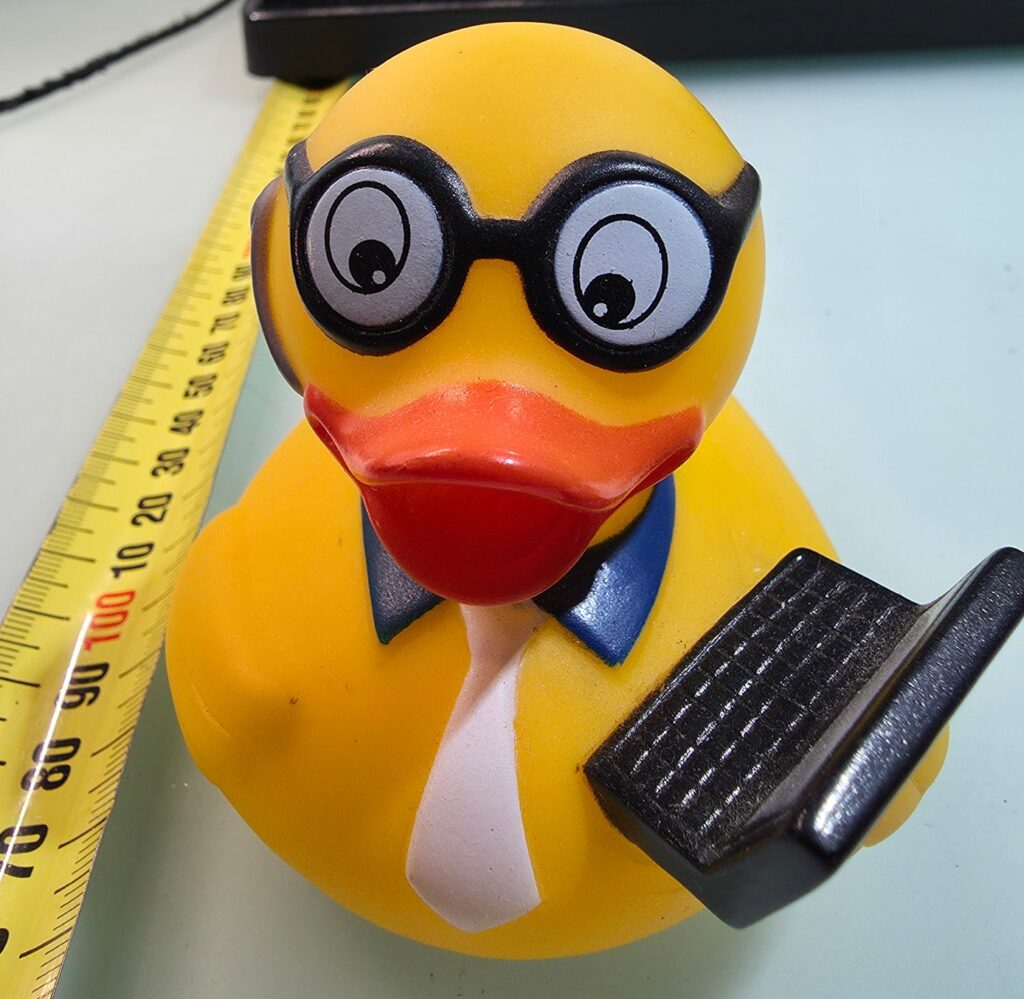


| Rear Primary | Wide |
| MP | 200MP bins to 12.5 |
| Sensor | Samsung S5KHP2 1/1.3” (same as S25 Ultra) released January 2023 |
| Focus | Multi-directional PDAF and Laser AF (same as S25 Ultra) |
| f-stop | 1.7 |
| um | .6 bins to 1.2 (50MP) and 2.4 (12.5MP) |
| FOV° (stated, actual) | 75.7 to 88.3 |
| Stabilisation | OIS |
| Zoom | 2x and 10X Crop from full frame (not optical) |
| Rear 2 | Ultra-wide/Macro |
| MP | 12MP |
| Sensor | Sony IMX564 |
| Focus | AF |
| f-stop | 2.2 |
| um | 1.4 |
| FOV (stated, actual) | 103.7 to 115.7 |
| Stabilisation | No |
| Zoom | No |
| Video max | 8K@30fps |
| Flash | Single |
| Auto-HDR | HDR 10-bit |
| QR code reader | Yes |
| Night mode | Nightography Astrography |
| DXO Mark | No |
Samsung Galaxy S25 Edge Selfie
In daylight, it produces excellent selfies with natural colours, skin tone, a wide dynamic range and plenty of detail.
In office light, they can be a little soft.
| Front | Selfie |
| MP | 12MP but produces 8.6MP video |
| Sensor | Samsung S5K3LU |
| Focus | AF |
| f-stop | 2.2 |
| um | 1.12 |
| FOV (stated, actual) | 75.4 to 88 |
| Stabilisation | No |
| Flash | Screen fill |
| Zoom | No |
| Video max | 4K@30 |
| Comment |
CyberShack’s View: Samsung Galaxy S25 Edge – Thin leads to compromise
We have already listed the compromises upfront, so if you have gotten this far, you will want to know our thoughts on the device. Samsung has introduced an alternative for those tired of carrying heavy phones.
There is no doubt that thin means more pocketable. It is lighter and looks and feels good in the hand. The compromises are not for power users, who need more. However, to Joe and Jane Average, this is a perfectly acceptable device, offering a premium handset with Gen 2 AI capabilities.
Its real competition is the Samsung Galaxy S25+, which has a better 6.7” screen, a better tri-camera, including telephoto, superior phone reception, and a 4900mAh 45W battery.
Samsung Galaxy S25 Edge ratings
| Features | 80 |
| While the SoC is capable of the best performance yet, throttling is so high that heavy users, such as gamers and videographers, lose that advantage. | |
| Value | 80 |
| There is no real competition for Snapdragon 8 Elite phones in Australia – they are all S25s. RRP 256GB (no promotion discounts): S25 $1399 S25 Edge $1849 S25+ $1699 S25 Ultra $2149 Clearly, the S25+ with a 6.7″ screen, 50+10+12MP camera and 4900mAh battery is a better value. Sure, it’s 7.3mm versus 5.8mm, but who cares? | |
| Performance | 80 |
| While the SoC is capable of the best performance yet, throttling is so high that heavy users like gamers and videographers lose that advantage. | |
| Ease of Use | 80 |
| Excellent 2+7+7 warranty/OS/patches, but Samsung UI 7.0. is getting overly complex with multi-layer and being forced to use Samsung Apps to access AI (instead of Google, which all Android users are familiar with). The complex, onerous, and extraordinarily lengthy privacy policy and terms are beyond comprehension for all but lawyers. | |
| Design | 80 |
| I like the flat screen, but the design is four generations old. Apple gets pilloried for its tick (new), tock, tick, tock (minor changes) design and Samsung runs that same risk. | |
| Rating out of 10 | 80 |
| Final comment | Thin versus hot and throttling and compromises all around. It’s obviously for bragging rights, and it does feel good in the pocket. |
| Pro | |
| 1 | Thin, but only if you accept the compromises over the rest of the S25s. |
| 2 | Battery life is adequate, but heavy users will need to charge perhaps twice daily. |
| 3 | Samsung quality |
| 4 | Thin versus hot and throttling and compromises all around. It’s obviously for bragging rights, and it does feel good in the pocket. |
| 5 | Powerful SoC but throttles terribly. |
| Con | |
| 1 | Colour inaccurate image preview 8-bit display |
| 2 | No charger and speed is not class-leading – quite slow. |
| 3 | USB-C is not fully implemented |
| 4 | City and Suburbs reception only – very strange for a Qualcomm SD8 Elite. |
| 5 | Samsung’s ecosystem is heading toward Apple’s walled garden. |
CyberShack Verdict
Samsung Galaxy S25 Edge
12/256GB $1849 and 12/512GB 2049 but shop around







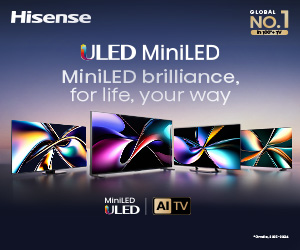

Comments